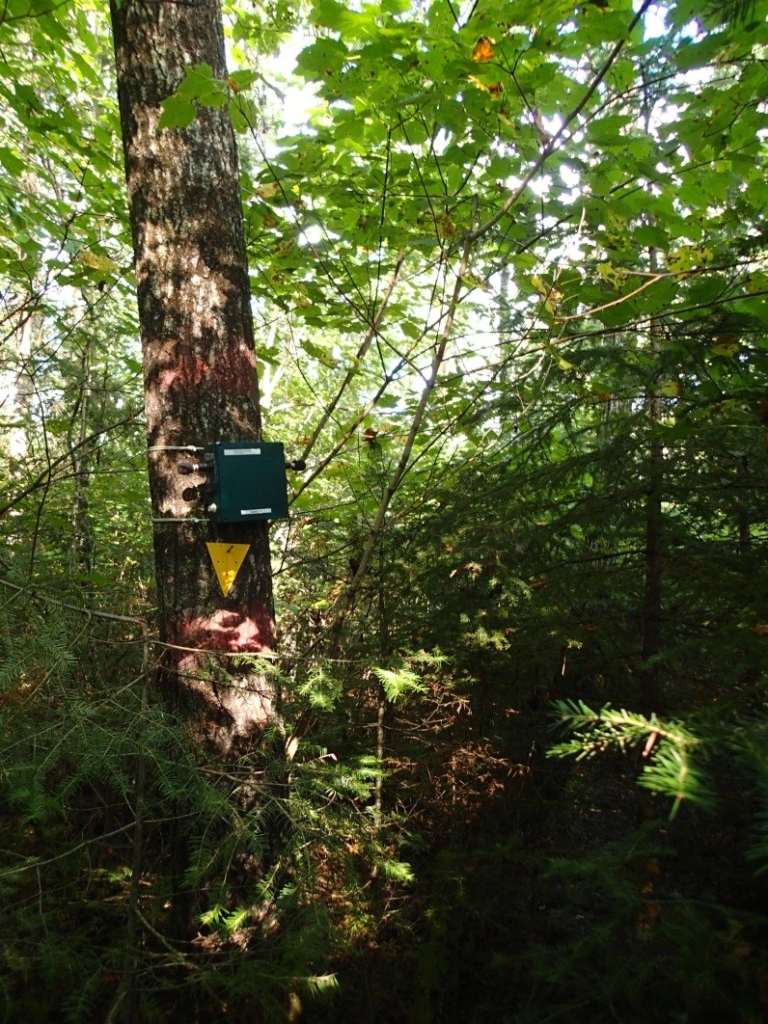
Jared Walter Stachiw and Cat Langille, Quetico Foundation Biology Interns/Quetico Provincial Park Assistant Biologists, paddling. Credit: Jill Legault
Songbird Monitoring update…1
Wetland Bird Monitoring introduction…2

An acoustic recording device setup at a permanent songbird plot in Quetico Provincial Park. Credit: Jared Walter Stachiw
Songbird Monitoring update:
Songbirds are often known for their beautiful songs, brilliant colours, and being a welcome sight in parks, at bird feeders, and in the wild. These birds aren’t only beautiful, their songs are also a convenient indicator of the health of the surrounding forest. Monitoring the richness and diversity of songbird species, and their changes through time, is useful for assessing the ecological condition, or health, of an area. The monitoring of songbirds within Quetico Provincial Park is a long-term study that began in 2014, with the collected data being used to assess the health of Quetico’s forests and songbird communities.

Jared Walter Stachiw and Cat Langille, Quetico Provincial Park Assistant Biologists/Quetico Foundation Biology Interns, getting ready for their excursion into Quetico Park to set up acoustic recording devices. Credit: Michael Davidson
This year the Quetico Foundation Biology Interns/ Quetico Provincial Park Biology team, Jared Stachiw and Cat Langille are helping to collect songbird data using audio recording equipment that records songbird’s calls at permanent songbird plots. This audio data is recorded at dawn, when songbirds are most vocal, ten times a year. Once the data is collected we can determine which birds are present within the forest during the recording. Collecting data for several years is important in order to analyze the trends and patterns in songbird populations over time. This data will provide information on the impacts of fire and other disturbances on songbird communities, information on avian species at risk that are present within the Park, and provide a better understanding of how fragmented landscapes impact songbird migration.
Wetland Bird Monitoring introduction:
Across Canada many wetlands are being lost due to human activity, such as development and pollution, especially in the densely populated Great Lakes basin. 2019 marks the inaugural year for marsh monitoring, using marsh birds as a surrogate for marsh health, in Quetico Provincial Park. Marsh birds are avian species that depend on marsh habitat for breeding and foraging. The presence of particular species of marsh birds, such as the least bittern (Ixobrychus exilis), sora (Porzana carolina), and pied-billed grebe (Podilymbus podiceps), provide an important indicator of marsh health.
The Quetico Foundation Biology Interns/ Quetico Provincial Park Biology team, Jared Stachiw and Cat Langille, are carrying out canoe surveys of the Pickerel River marsh to track which species are found in this wetland area. These surveys will occur three times this summer to gain an understanding of the health of this wetland. Canoes surveys of the Pickerel River marsh will continue for the foreseeable future to create a long-term data set which will allow for year-to-year comparisons of which marsh birds are present and what this means for marsh health.

Marsh cinquefoil (Comarum palustre), a beautiful wetland shrub found throughout the Quetico-Superior area. Credit: Brian Jackson
You too can assist with marsh bird monitoring via the Marsh Monitoring Program, which offers everyone, from novice to professional, the opportunity to contribute to the conservation of marsh ecosystems. To learn more about this program visit https://www.birdscanada.org/volunteer/glmmp/.
By: Jared Walter Stachiw









Leave A Comment